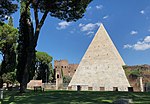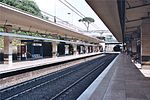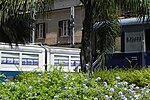Protestant Cemetery, Rome

The Cimitero Acattolico (Non-Catholic Cemetery) of Rome, often referred to as the Cimitero dei protestanti (Protestant Cemetery) or Cimitero degli Inglesi (English Cemetery), is a private cemetery in the rione of Testaccio in Rome. It is near Porta San Paolo and adjacent to the Pyramid of Cestius, a small-scale Egyptian-style pyramid built between 18 and 12 BC as a tomb and later incorporated into the section of the Aurelian Walls that borders the cemetery. It has Mediterranean cypress, pomegranate and other trees, and a grassy meadow. It is the final resting place of non-Catholics including but not exclusive to Protestants or British people. The earliest known burial is that of a Dr Arthur, a Protestant medical doctor hailing from Edinburgh, in 1716. The English poets John Keats and Percy Bysshe Shelley are buried there.
Excerpt from the Wikipedia article Protestant Cemetery, Rome (License: CC BY-SA 3.0, Authors, Images).Protestant Cemetery, Rome
Viale del Campo Boario, Rome Municipio Roma I
Geographical coordinates (GPS) Address Nearby Places Show on map
Geographical coordinates (GPS)
| Latitude | Longitude |
|---|---|
| N 41.8764 ° | E 12.4799 ° |
Address
The Garden Room
Viale del Campo Boario
00154 Rome, Municipio Roma I
Lazio, Italy
Open on Google Maps











